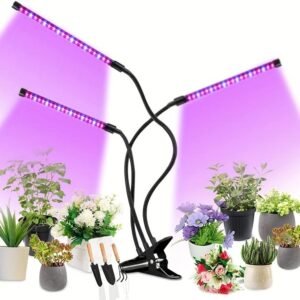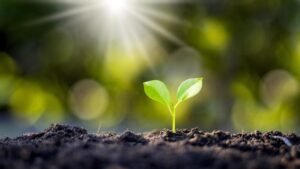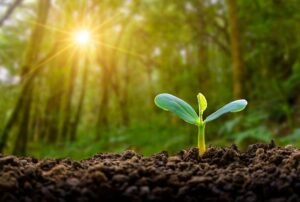What color Light is best for plant growth?
The color of light that is best for flora growth is primarily blue and red.
–>Blue Light:
Blue light is essential for promoting vegetative growth, including leaf development and root formation. It plays a crucial role in regulating flora processes like photosynthesis and phototropism.

- Photosynthesis:
Blue light plays a crucial role in photosynthesis, the process by which plants convert light energy into chemical energy. It is absorbed by chlorophyll, the green pigment in flora cells, to drive photosynthetic reactions.
- Stomatal Regulation:
Blue light helps regulate stomatal opening and closing. Stomata are tiny pores on flora leaves that control gas exchange, including the intake of carbon dioxide and the release of oxygen and water vapo
- Photomorphogenesis: Blue light influences various aspects of flora development and morphology through a process called photomorphogenesis. It affects processes such as seedling growth, leaf expansion, and stem elongation
–>Red Light:
Red light is crucial for flowering and fruiting stages of plants. It stimulates the production of chlorophyll, which is necessary for photosynthesis, and also influences the plant’s overall growth and development.

- Photosynthesis:
Like blue light, red light is essential for photosynthesis. It is absorbed by chlorophyll and other pigments in flora cells, driving the light-dependent reactions of photosynthesis.
- Flowering and Fruit Production:
Red light plays a critical role in regulating flowering and fruiting in plants. It is often associated with the transition from vegetative growth to reproductive growth.
- Stem Elongation:
Red light promotes stem elongation in plants. It can stimulate the production of auxin, a flora hormone that regulates cell elongation and growth. In certain situations, such as when plants are grown under low-light conditions, an excess of red light relative to blue light can lead to elongated and spindly growth.
–>Full Spectrum Light:
While blue and red light are essential, plants also require other colors within the spectrum for optimal growth. Full spectrum light, which includes all colors of the rainbow, provides a balanced spectrum that supports various stages of flora growth.

- Comprehensive Coverage:
Full spectrum light provides a balanced mix of wavelengths that closely mimics natural sunlight. This comprehensive coverage ensures that plants receive all the light they need for optimal growth and development.
- Photosynthesis:
Full spectrum light supports all stages of photosynthesis by providing the necessary wavelengths of light for chlorophyll absorption. Blue and red wavelengths are particularly important for driving photosynthetic reactions, while other wavelengths contribute to overall energy capture and efficiency.
- Flora Morphology:
Exposure to full spectrum light can influence flora morphology and structure. Balanced light spectra promote sturdy growth, compact habit, and healthy leaf development.
–>Intensity and Duration:
In addition to color, the intensity and duration of light exposure also play significant roles in flora growth. Different plants have different light requirements, so it’s essential to provide the appropriate intensity and duration of light for each species.

- Intensity:
The intensity of light refers to the amount of light energy that reaches the Flora’s surface per unit area, typically measured in units such as lux or photosynthetic photon flux density (PPFD).
- Duration:
The duration of light exposure refers to the length of time that floras are exposed to light within a 24-hour period, commonly referred to as the photoperiod. Photoperiodic responses vary among flora species and can influence critical developmental processes such as flowering, dormancy, and vegetative growth.
–>LED Grow Lights:
LED grow lights are popular among indoor gardeners because they can be customized to emit specific wavelengths of light, including blue and red, to meet the needs of different floras at various growth stages.

- Customizable Spectra:
LED grow lights allow growers to customize the light spectrum emitted by the fixtures. This customization enables growers to tailor the light spectrum to the specific requirements of different flora species, growth stages.
- Red and Blue Spectra:
The most commonly used colors in LED grow lights are red and blue, as these wavelengths are essential for flora growth and development. Red light (around 630-660 nanometers) promotes flowering, fruiting.
- Optimal Ratios:
While both red and blue light are important, the optimal ratio of red to blue light may vary depending on the flora species and growth stage.
–>Natural Sunlight:
While artificial lighting can be used for indoor gardening, natural sunlight remains the most potent and well-rounded light source for plants. It provides a full spectrum of light and is essential for healthy flora growth.

- Photosynthesis and Light Absorption:
Exploring how plants absorb and utilize different colors of light during photosynthesis, with a focus on chlorophyll pigments and their absorption spectra.
- Role of Blue Light in Flora Growth:
Investigating the specific roles of blue light in promoting vegetative growth, regulating stomatal opening, and influencing phototropism in plants.
- Red Light and Flowering Induction:
Examining how red light triggers flowering and fruiting responses in plants through the activation of phytochrome photoreceptors.
- UV Light and Secondary Metabolite Production:
Investigating the influence of ultraviolet (UV) light on the production of secondary metabolites in plants, including defense compounds and antioxidants.
Interesting facts about photography camera guides ,photo editing Click here

1 thought on “What color Light is best for plant growth?”